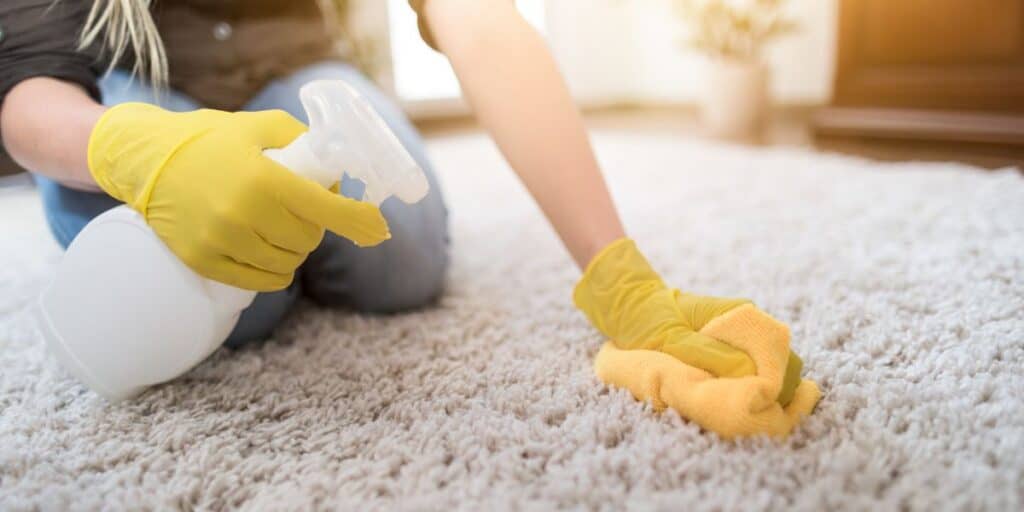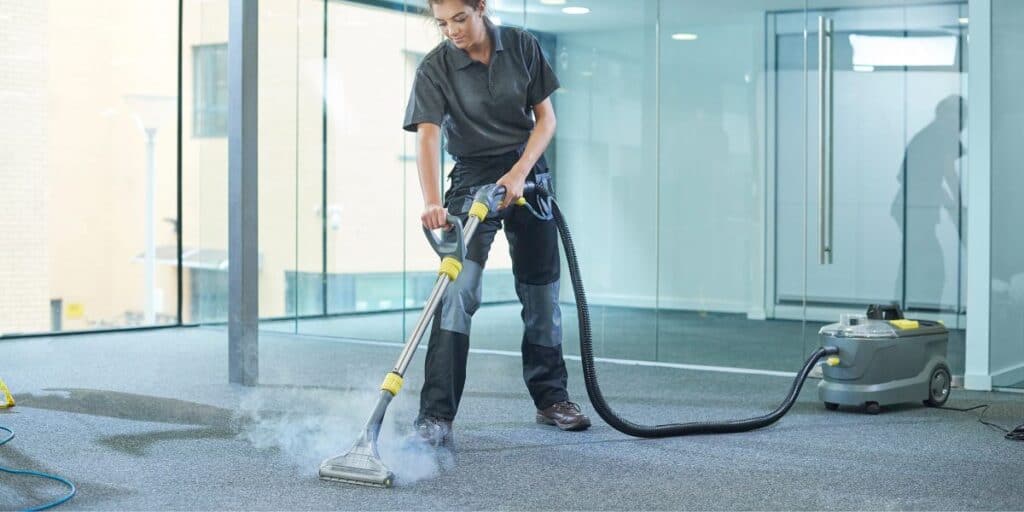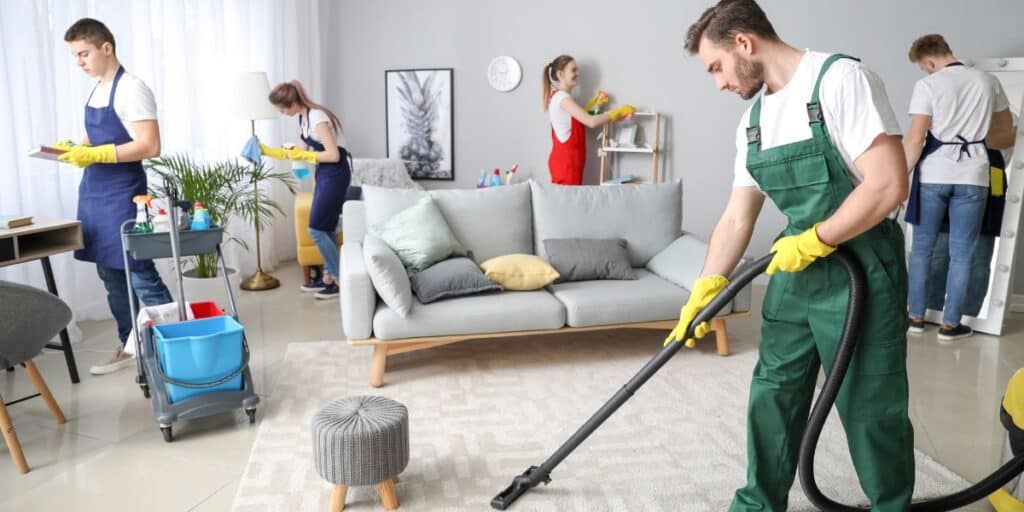Carpets can be the centerpiece of any room, providing both comfort and style to your living space. However, keeping them clean and fresh requires some effort. With so many different carpet cleaning methods available, it can be challenging to determine the best one for your specific needs, considering factors like effectiveness, safety, cost, process time, as well as pros and cons. You might be wondering: what’s the most effective carpet cleaning method tailored to your unique situation?
The ideal carpet cleaning method varies based on factors like carpet type, dirt level, and priorities such as safety, cost, and efficiency. For deep cleaning and allergen removal, steam cleaning is recommended. For faster cleaning with minimal drying time, dry cleaning is a good option.
To help you make an informed decision, this article will compare various carpet cleaning methods and their advantages and disadvantages. By the end of this informative piece, you’ll have a better understanding of which method suits your particular needs. So, buckle up as we unveil the best carpet cleaning options for different situations, ensuring you maintain a fresh and welcoming atmosphere in your living space.
Best Carpet Cleaning Methods By Effectiveness Against Specific Purposes
In this section, we’ll discuss various carpet cleaning methods and their effectiveness in achieving different purposes, such as stain removal, allergen and dust removal, pet odor neutralization, and mold and mildew prevention.

Stain Removal
When it comes to removing stains from your carpet, there are several methods you can use, each with its own advantages and disadvantages:
- Shampooing: This method uses a foamy detergent to break down dirt and oil in your carpet. It’s a popular choice for removing mud stains and debris. However, it may not be the most effective solution for removing deep-set stains or heavily soiled carpets.
- Steam cleaning: Also known as hot water extraction, steam cleaning uses hot water and a cleaning solution to loosen dirt and stains. This method is often considered the best for deep cleaning and removing stubborn stains. One drawback is the longer drying time compared to other methods.
Allergen and Dust Removal
If allergens and dust are a concern for you, consider the following carpet cleaning methods:
- Vacuuming: Regular vacuuming is essential for removing surface-level allergens and dust from your carpets. Choose a vacuum with strong suction and a HEPA filter to trap as many allergens as possible.
- Deep cleaning: Both steam cleaning and shampooing can help remove allergens trapped deep within your carpet fibers, though steam cleaning may be more effective at eliminating bacteria and allergens.
Pet Odor Neutralization
For pet owners, neutralizing pet odors is often a priority when cleaning carpets. Here are some methods to consider:
- Specific pet odor removal solutions: These products are designed to remove stubborn pet odors and stains from your carpet. You can use them as a spot treatment or as part of a deep cleaning process.
- Steam cleaning: The high temperatures used in steam cleaning can help break down and neutralize pet odors. This method might be a better option for extensive odor issues throughout your home.
Mold and Mildew Prevention
Mold and mildew can be an issue in humid environments or when carpets are not dried properly after cleaning. Here are some carpet cleaning methods that can help prevent their growth:
- Dry cleaning: This method uses little to no water, reducing the risk of mold and mildew growth due to moisture. It’s an excellent option for lightly-soiled carpets but may not provide the deep cleaning needed for heavily-soiled carpets.
- Quick-drying techniques: When using steam cleaning or shampooing methods, opt for equipment with powerful suction to minimize moisture and reduce drying time.
| Carpet Cleaning Method | Stain Removal | Allergen and Dust Removal | Pet Odor Neutralization | Mold and Mildew Prevention | Pros | Cons |
|---|---|---|---|---|---|---|
| Shampooing | Yes | Yes | No | No | Effective for mud stains and debris | Not as effective for deep-set stains or heavily soiled carpets |
| Steam Cleaning | Yes | Yes | Yes | No | Excellent for deep cleaning and stubborn stains | Longer drying time |
| Vacuuming | No | Yes | No | No | Simple method for regular maintenance | Not suitable for deep cleaning |
| Dry Cleaning | Yes | Yes | No | Yes | Prevents mold and mildew growth | Not effective for heavily-soiled carpets |
| Pet Odor Removal Solutions | No | No | Yes | No | Targets stubborn pet odors and stains | Should be used with other cleaning methods |
In conclusion, it’s essential to choose the carpet cleaning method that best suits your needs based on the specific issues you’re trying to address, such as stain removal, allergen and dust removal, pet odor neutralization, or mold and mildew prevention.
Best Carpet Cleaning Methods From Safety Aspect
When choosing a carpet cleaning method, safety is a top priority. In this section, we’ll discuss various aspects of safety pertaining to carpet cleaning methods, from eco-friendly products to minimizing risks from harsh chemicals.
Eco-Friendly Products
Opting for eco-friendly cleaning solutions can greatly improve the safety of your carpet cleaning experience. These products typically use natural, biodegradable ingredients, which have a lower environmental impact and are gentler on carpets. Some eco-friendly cleaning agents you may consider using:
- Baking soda: can effectively remove odors and stains
- White vinegar: helps in eliminating grime and neutralizing odors
- Castile soap: a plant-based soap effective for cleaning dirt and stains
By choosing these eco-friendly solutions, you ensure a safer and more sustainable cleaning process.
Safe for Children and Pets
Safety for children and pets is essential when cleaning your carpets. Kids and pets tend to spend more time on carpets, increasing their exposure to cleaning agents. To ensure their safety, look for products that are:
- Non-toxic
- Hypoallergenic
- Free from harsh chemicals
- Specifically labeled as safe for children and pets
These products will not only protect your loved ones but also maintain the cleanliness and appearance of your carpets.
Minimizing Risks from Harsh Chemicals
Using harsh chemicals in your carpet cleaning process can pose a risk to your health and the environment. To minimize these risks, follow these tips:
- Always wear gloves when handling strong cleaning agents
- Ensure proper ventilation during the cleaning process
- Consider using milder, eco-friendly alternatives when possible
- Follow the manufacturer’s instructions for using and disposing of cleaning solutions
By being cautious and responsible, you can minimize the potential hazards associated with harsh chemical use.
Safety Summary Table
| Method | Safety Aspect | Pros | Cons |
|---|---|---|---|
| Steam Cleaning (Hot Water Extraction) | Non-toxic, pet-friendly, child-safe | Effective cleaning, sanitized carpets | Longer drying time, risk of mold if not dried properly |
| Dry Cleaning (Absorbent Compound) | Low-moisture, eco-friendly options available | Fast drying, minimal disruption | Less effective in deep cleaning, residue may remain |
| Encapsulation | Improved safety with encapsulation products | Eco-friendly, no rinse required | Not ideal for heavily soiled carpets |
| Bonnet Cleaning | Safe for children and pets with proper products | Fast cleaning, ideal for maintenance cleanings | Not suitable for deep cleaning, may damage carpet fibers |
By considering these aspects when choosing a carpet cleaning method, you ensure a clean and secure environment for you and your loved ones.
Best Carpet Cleaning Methods By Cost
When considering the best carpet cleaning method for you, cost is an important factor to take into account. This section will discuss the difference in costs for DIY methods versus hiring professional services, as well as provide pricing information for popular carpet cleaning companies.
DIY vs Professional Services
When it comes to cleaning your carpets, you may choose to clean them yourself or hire a professional carpet cleaning company.
- DIY carpet cleaning can be a cost-effective option, especially if you are on a tight budget. Common DIY methods include using a steam cleaner or renting a carpet cleaning machine. These options can cost anywhere from $20 to $200 depending on the equipment and cleaning products you decide to use.
- Hiring professional services is typically more expensive, but the benefits include efficiency, deeper cleaning, and a faster process. Prices for professional cleaning vary but typically range from $100 to $500, depending on the size of your home and the extent of the cleaning required.
A Quick Cost Comparison
| Cleaning Method | Cost Range | Pros | Cons |
|---|---|---|---|
| DIY (Steam Cleaner) | $20 – $200 | Affordable, flexible schedule | Time-consuming, manual labor required |
| Professional | $100 – $500 | Deep cleaning, time-saving, expertise | More expensive, schedule availability |
Pricing of Popular Carpet Cleaning Companies
Several well-known carpet cleaning companies offer quality services at competitive prices. Here are some examples:
- Stanley Steemer offers a variety of services, with carpet cleaning ranging from $99 to $200 depending on the number of rooms you need cleaned. Special treatments, like stain removal or pet odor treatments, may add to the cost.
- Oxi Fresh Carpet Cleaning uses a green, low-moisture process that is safe for the environment, with prices ranging from $100 to $250 based on the package you choose.
- Servpro specializes in residential and commercial carpet cleaning, with prices varying depending on your specific requirements and location. Contact them for a customized quote.
Remember to compare prices, read reviews, and consider your specific needs when choosing a carpet cleaning company. The right choice will help you achieve clean and fresh carpets without breaking the bank.
Best Carpet Cleaning Methods By Process Time
Drying Time
Drying time is an essential factor to consider when choosing a carpet cleaning method. Different methods have varying drying times. For example:
- Hot water extraction: This method extracts most of the moisture from your carpet, resulting in a drying time of around 6-12 hours.
- Dry cleaning: As this method uses little to no water, your carpet is usually dry within an hour or less.
- Steam cleaning: This method may take longer to dry (up to 24 hours), depending on the equipment and moisture removal efficiency.
Here’s a table summarizing the drying time aspect of each mentioned method:
| Method | Drying Time | Pros | Cons |
|---|---|---|---|
| Hot Water Extraction | 6-12 hours | Deep cleaning, effective at removing stains and dirt | Longer drying time |
| Dry Cleaning | 1 hour or less | Fastest drying time, minimal disturbance to your daily routine | May not remove deep-set stains |
| Steam Cleaning | Up to 24 hours | Effective for sanitization, kills bacteria and allergens | Longest drying time, risk of mold if not dried properly |
Preparation and Cleaning Duration
Preparing your carpet for cleaning can take some time. Remove furniture, vacuum the area thoroughly, and pre-treat stains before the actual cleaning process starts.
- Hot water extraction: This method may take longer, typically 2-3 hours for an average room, as it requires a more thorough cleaning process.
- Dry cleaning: This method is faster, usually taking 1-2 hours to complete.
- Steam cleaning: Similar to the hot water extraction method, steam cleaning can take 2-3 hours to complete, depending on the carpet’s size and condition.
Downtime Impact
Downtime can impact your daily routine, especially if you need access to the carpeted area during the cleaning process.
- Hot water extraction: Due to the longer drying time, this method may cause more significant downtime. Plan your schedule accordingly and avoid walking on the wet carpet.
- Dry cleaning: The minimal drying time for this method means less downtime, allowing you to return to your daily routine relatively quickly.
- Steam cleaning: As this method has the longest drying time, plan for increased downtime and avoid activities on the affected area until completely dry.
By considering the drying time, preparation and cleaning duration, and downtime impact, you can make an informed decision when selecting the best carpet cleaning method for your needs.
Pros and Cons

Advantages and Disadvantages of Popular Methods
When it comes to cleaning your carpet, there are various methods to choose from, each with their own set of advantages and disadvantages. In this section, we will explore the pros and cons of some popular carpet cleaning methods.
Encapsulation cleaning
Pros:
- It is an eco-friendly and less disruptive option, as it uses less water and takes less time to dry.
- Encapsulation cleaning is able to remove old visible stains and urine odors effectively.
- It is suitable for large areas and can be used for regular maintenance cleaning.
Cons:
- Not effective for removing heavy stains or dirt buildup.
- The encapsulation cleaning method might not be as deep or thorough as other methods, like steam carpet cleaning.
Steam carpet cleaning
Pros:
- Steam cleaning is often the go-to method for deep cleaning carpets due to its ability to remove dirt from deep within the fibers.
- Capable of removing stubborn stains like wine, juice, and vomit.
- The hot water extraction process kills bacteria, making your carpet fresh and sanitized.
Cons
- The lengthier drying time could be a problem, as carpets can take up to 24 hours to dry completely.
- The cost of hiring professional steam carpet cleaners can be higher in comparison to other methods.
Dry powder cleaning
Pros:
- One of the fastest carpet cleaning methods, as there is no drying time involved.
- Uses less water, making the process more eco-friendly.
- Quite effective in removing light soiling and for maintenance cleaning.
Cons:
- It might not be suitable for heavily soiled carpets or for carpets with stubborn stains.
- The use of improper cleaning solutions may cause residues to build up on your carpet.
| Method | Pros | Cons |
|---|---|---|
| Encapsulation | Eco-friendly, effective for maintenance | Not suitable for heavy stains |
| Steam carpet cleaning | Deep cleaning, removes stubborn stains | Longer drying time, higher cost |
| Dry powder cleaning | Fast, no drying time, eco-friendly | Not suitable for heavily soiled carpets |
Remember, the best method for your carpet depends on the type of stains and the extent of dirt buildup. Consider the pros and cons of each method, and select the one that suits your needs and circumstances most effectively.
By using these tips and tricks, you can keep your carpets looking fresh and clean without the need for professional assistance. Remember to always follow the manufacturer’s guidelines for the care and cleaning of your specific carpet type. Happy cleaning!
Selecting a Professional Carpet Cleaning Service
When it comes to keeping your carpets fresh and clean, choosing the right professional carpet cleaning service is essential. To ensure a satisfying and effective cleaning experience, consider the following factors while selecting a service:
- Effort: Evaluate how much effort you’re willing to put into the preparation and post-cleaning process. Some professional services handle furniture moving and room preparation, while others expect you to take care of that beforehand.
- Reputation: A reputable carpet cleaning service with reliable customer reviews is always a safer bet. Don’t hesitate to ask friends, neighbors, or colleagues for recommendations, or check online platforms for ratings and testimonials.
- Safety: Always prioritize safety when selecting a carpet cleaning service. Choose a company that uses eco-friendly, non-toxic cleaning solutions and follows necessary safety protocols to protect your family and pets.
- Cost: While it’s essential to consider the budget, don’t opt for a service solely based on the lowest price. Instead, focus on finding a company that provides value for your money by offering quality cleaning, excellent customer service, and reasonable rates.

Here are some additional tips for making your decision:
- Look for a service that offers a wide range of cleaning methods, such as steam cleaning, dry cleaning, and deep cleaning. This ensures you’ll have access to the most suitable option for your specific carpet requirements.
- Steam cleaning uses a hot water extraction method, providing a deep clean with longer drying times.
- Dry cleaning employs less water and utilizes chemical solutions, resulting in a quicker drying process.
- Deep cleaning combines multiple techniques for a comprehensive and thorough approach.
- Inquire about the cleaning process and expected completion time. Knowing how long the job will take helps you plan accordingly and manage expectations.
- Ask about the company’s guarantees and warranties. A reputable provider will stand by their work, offering you peace of mind with assurance that they’ll fix any potential issues.
Remember, you deserve the best when it comes to maintaining the cleanliness and longevity of your carpets. By carefully considering these factors and doing some research, you’ll be well on your way to finding the perfect professional carpet cleaning service for your needs.
Conclusion
Finally, to conclude, below is a quick table providing a detailed comparison of popular carpet cleaning methods.
| Method | Effectiveness by Purpose | Safety | Cost | Process Time | Pros | Cons |
|---|---|---|---|---|---|---|
| Hot Water Extraction | Deep cleaning | High | Medium | Longer | Highly effective, suitable for most fibers | Longer drying time, risk of over-wetting |
| Dry Cleaning | Light to medium cleaning | High | Medium | Shorter | Fast process, quick drying | Less effective for deep stains, can be harsh on fibers |
| Carpet Shampooing | Deep cleaning | Medium | High | Longer | Can remove tough stains, dirt, and debris | Longer drying time, risk of residue |
| Encapsulation | Light to medium cleaning | High | Low | Shortest | Environmentally friendly, low moisture | Less effective for heavily soiled carpets or oil stains |
| Bonnet Cleaning | Surface cleaning | High | Low | Shortest | Quick and easy, suitable for light cleaning and maintenance | Not suitable for deep cleaning or heavily soiled carpets |
Frequently Asked Questions
What are the top methods for cleaning carpets?
Some popular carpet cleaning methods include steam cleaning, chem-dry (chemical dry cleaning), and shampooing. These methods vary in process, cost, and effectiveness, so it’s essential to choose the right one for your needs.
How do steam cleaning and chem-dry compare?
- Steam cleaning uses hot water extraction, which effectively removes deep-set dirt and allergens. It may leave carpets damp, requiring a few hours to dry.
- Chem-dry, on the other hand, employs a chemical cleaning process with less moisture, resulting in quicker drying times but potentially less thorough cleaning.
Which carpet cleaning method is most cost-effective?
While costs can vary, steam cleaning is often considered the most cost-effective carpet cleaning method. It provides deep cleaning at an affordable price, but always compare quotes from different providers before making a decision.
How long does each cleaning process take?
- Steam cleaning may take around 2-4 hours for an average-sized room, not including drying time.
- Chem-dry usually requires less time, approximately 1-2 hours per room with minimal drying time necessary.
- Shampooing may take around 3-4 hours per room, plus additional drying time.
What are the pros and cons of different carpet cleaning techniques?
- Steam cleaning:
- Pros: Deep cleaning, affordable, eco-friendly.
- Cons: Longer drying time.
- Chem-dry:
- Pros: Quick drying, less water usage.
- Cons: Less effective, uses chemicals.
- Shampooing:
- Pros: Effective for oily stains.
- Cons: Longer drying time, might leave residue.
Which cleaning method is safest for carpets and households?
Steam cleaning is generally considered the safest option for both carpets and households. It uses hot water and eco-friendly solutions, ensuring no harmful chemicals are left behind. However, ensure to check your carpet manufacturer’s recommendations before proceeding.
